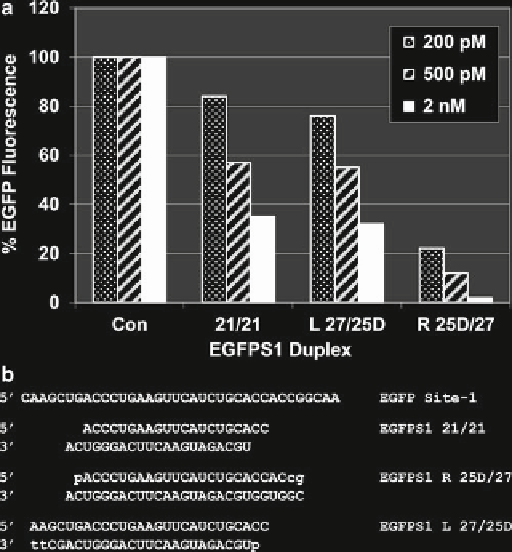Biology Reference
In-Depth Information
Fig. 2.2
“R” form duplexes are more potent than “L” form duplexes. (
a
) An EGFP expression
plasmid was transfected into HEK293 cells. Anti-EGFP or control dsRNAs were transfected 24 h
later at the indicated concentrations. At 24 h post-transfection, relative fluorescence was measured
setting the control cultures at 100%. (
b
) The EGFP site 1 mRNA target sequence is shown at the
top with 21-nt and asymmetric 25/27-nt DsiRNAs aligned below. RNA bases are
uppercase
and
DNA bases are
lowercase
. “p” indicates a 5¢-phosphate. Reprinted from Rose et al. [
31
] with per-
mission from Oxford University Press
ejected as the passenger strand. The primary feature contributing to loading bias
relates to thermodynamic end asymmetry [
33-
35
]; it now appears that end structure
(3¢-overhang vs. blunt) also plays a role [
31,
32
]. Interestingly, a recent report from
the Doudna group demonstrated that Dicer is integrally involved in strand selection
during RISC formation, lending additional credibility to the functional polarity
observed using Dicer-substrate siRNAs in the studies discussed above [
36
] .
2.2.1.3
Functional Potency of DsiRNAs
A study was performed at the Bio-Rad laboratories by Eli Hefner, Teresa Rubio, and
colleagues to validate the performance of the newly optimized DsiRNA design [
37
] .
A set of five genes were selected as targets, including
ACTB
,
AKT1
,
RAF1
,
CDK2
,
and
TP53
. For each gene, an asymmetric 25/27-nt DsiRNA targeting that gene and
the cognate 21-nt siRNA were compared for potency and duration of silencing.

Search WWH ::

Custom Search